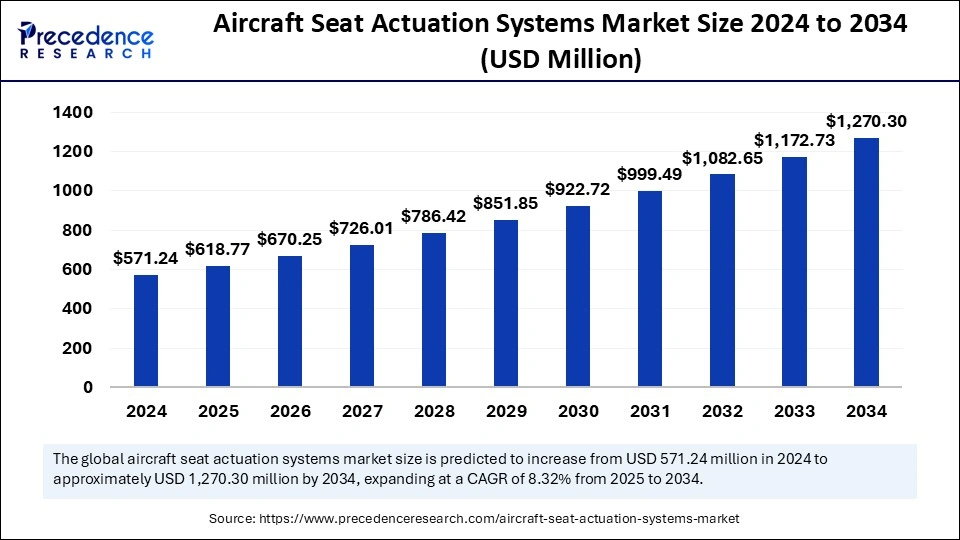Aircraft seat actuation systems market size is forecasted to grow from USD 571.24 million in 2024 to USD 1,270.30 million by 2034, at a CAGR of 8.32% during the forecast period.

Aircraft Seat Actuation Systems Market Key Takeaways
-
In 2024, North America captured the largest market share at 35%.
-
From 2025 to 2034, Asia Pacific is set to expand at a notable CAGR.
-
The economy segment led by passenger class, holding a 42% market share in 2024.
-
Premium economy is anticipated to record the highest CAGR over the 2025–2034 forecast period.
-
Electromechanical actuators were the dominant type in the global market in 2024.
-
Linear mechanisms held the biggest share of 63% in 2024 by mechanism.
-
Rotary mechanisms are expected to witness strong CAGR growth through the forecast period of 2025 to 2034.
Aircraft Seat Actuation Systems Market Overview
The aircraft seat actuation systems market plays a critical role in enhancing passenger experience by offering adjustable and ergonomic seating in commercial and business aircraft. These systems are increasingly becoming standard in premium cabins and are expanding into economy class with simplified versions.
Market growth is being driven by evolving airline strategies that prioritize cabin customization and passenger-centric features. As aircraft cabins become smarter and more connected, seat actuation systems are being designed with greater precision and embedded sensors for real-time feedback and control.
Drivers
Key drivers for market expansion include the increasing demand for comfort in long-haul flights and the growing focus on reducing aircraft weight. Airlines are investing in seats with smart actuation systems that provide multiple adjustment options while consuming minimal power.
In addition, the trend toward personalization in aviation services is fueling the demand for seat systems that can adapt to individual passenger preferences. The replacement of hydraulic systems with electro-mechanical ones is also propelling market growth due to improved efficiency and lower maintenance requirements.
Opportunities
The future of the aircraft seat actuation systems market lies in the integration of digital technologies, such as IoT and machine learning. These technologies can enable predictive maintenance, seat usage analytics, and automated comfort settings. Manufacturers have opportunities to innovate with modular actuation units that are easier to install and service.
The expansion of urban air mobility and short-range electric aircraft also opens a new segment for compact and lightweight seat actuation solutions tailored for these emerging platforms.
Challenges
Cost sensitivity in the aviation sector remains a significant challenge, especially for low-cost carriers that may not prioritize high-end seating features. The development of customized actuation systems requires significant R&D investment, which can strain resources for smaller manufacturers.
Reliability and safety are paramount in aviation, and seat actuation systems must meet stringent certification requirements. Achieving a balance between functionality, weight, and compliance can delay time-to-market and add to development expenses.
Regional Insights
North America continues to dominate the aircraft seat actuation systems market, largely due to the concentration of aircraft OEMs, technology providers, and a mature aviation industry. Europe follows, with strong contributions from countries like France, Germany, and the UK, which are home to leading aerospace firms and design hubs.
The Asia-Pacific region is emerging as a lucrative market with a growing number of commercial airlines and aircraft orders. Countries like China and India are investing heavily in aviation infrastructure and are likely to be key growth drivers over the next decade.
Recent Developments
In recent years, market players have introduced advanced seat actuation systems with integrated touchscreen controls, wireless connectivity, and AI-driven comfort adjustments. Industry collaborations are leading to rapid innovation, particularly in the area of lightweight materials and compact design.
Some companies are exploring the use of recyclable composites and 3D-printed components to streamline production and improve sustainability. There is also a noticeable trend toward the development of adaptive systems that adjust based on passenger biometrics or flight conditions.
Aircraft Seat Actuation Systems Market Companies
- Astronics Corporation
- Bühler Motor GmbH
- Crane Company
- NOOK Industries, INC.
- Rollon S.p.A.
- SAFRAN
- Kyntronics
- Moog Inc.
- ITT INC.
- RTX
- Honeywell International Inc.
Segments Covered in the Report
By Passenger Class
- Economy
- Premium Economy
- Business
- First Class
By Actuator
- Electromechanical
- Others
By Mechanism
- Linear
- Rotary
By Region
- North America
- Asia Pacific
- Europe
- Latin America
- Middle East and Africa
Ready for more? Dive into the full experience on our website!